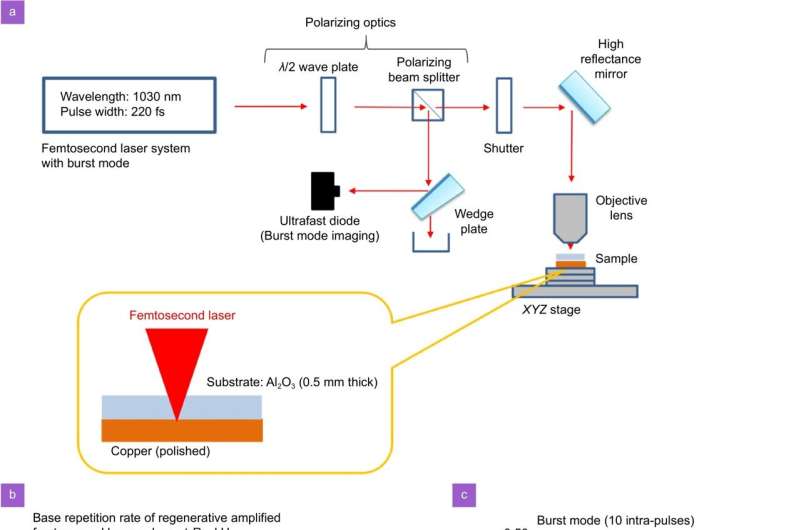
Schematic illustrations of (a) experimental setup for the GHz burst LIPAA process, (b) a pulse form of GHz burst mode containing P intra-pulses, and the measured waveforms of (c) a GHz burst pulse with 10 intra-pulse numbers and (d) a pulse at the single-pulse mode operation as comparison. Credit: Opto-Electronic Science (2024). DOI: 10.29026/oes.2024.230053
A new publication in Opto-Electronic Science discusses forbidden propagation of hyperbolic phonon polaritons and applications in near-field energy transport.
Manipulating photons on the nanoscale to develop integrated and miniaturized optoelectronic devices as well as photonic chips has been a strong pursuit of the nanophotonics community. Among them, phonon polaritons supported by two-dimensional layered van der Waals (vdW) materials, which have emerged in recent years, have attracted much attention by virtue of their ultra-long lifetimes, ultra-low losses, and strong confinement capabilities, and have shown great promise in the fields of sub-wavelength imaging, anomalous refraction, superlensing, thermal management, and more.
A vibrant research field is emerging to break through the diffraction limit of conventional optics in the form of polaritons and to manipulate the interaction between light and matter.
Tunable phonon polaritons are the basis for enhanced manipulation of photonic devices. Currently available tuning strategies for phonon polaritons are mostly limited to the construction of nano-patterned structures on the vdW material itself, such as sub-wavelength periodic array structures (such as gratings), or twisted multilayered structures to create an photonics magic angle, as well as electromagnetic tunable construction of vdW heterojunctions based on graphene, where the nanostructures increase losses, and twisting limits the application of monolayer materials.
Exploring more modulation methods is important to manipulate the excitation and propagation of phonon polaritons. In addition, it is of great practical value to explore the effect of phonon polaritons coupling on near-field thermal energy transport.
The authors of the new study propose a strategy to drive the phonon polaritons propagation in vdW material (molybdenum trioxide, α-MoO3) with the help of the substrate, so that the direction of the propagation direction of hyperbolic phonon polaritons can be reoriented by 90° to achieve the forbidden propagation. At the same time, the role of substrate-dependent phonon polaritons coupling in near-field thermal radiation is described and the influence of the correlation between width of air spacing and thickness of α-MoO3 slab on the radiative heat transfer is investigated.
Based on the derivation of the dispersion equation, the team members theoretically provide the relationship between the propagation direction of hyperbolic phonon polaritons and the substrate dielectric function, which shows that the hyperbolic phonon polaritons along the x-axis and the y-axis is forbidden to propagate when there is no substrate or the real part of the substrate dielectric function is positive.
In contrast, when the real part of the substrate dielectric function is negative and its absolute value is not too big, such as in SiC, the direction of propagation is reoriented by 90°, and then it can propagate along the forbidden direction. For metallic substrates such as Au, the fundamental mode can be excited with l=0, compared to the suspended configuration where the lowest mode is l=1.
Substrate-dependent polaritons are applied to radiative heat transfer to investigate the effect of SiC and Au substrates on the NFRHT between two α-MoO3 slabs and compare it with the case without substrate. It is found that whether the SiC substrate enhances or suppresses the radiation depends on the relative amplitude of thickness of the α-MoO3 slab and the width of air spacing.
When the vacuum width varies, the whole region can be divided into a nearly inactive region, an inhibition region, and an enhancement region from left to right based on the effect of SiC. In other words, for a certain thickness, the smaller the spacing width, the less effective it is. This is due to the fact that when the spatial distance is smaller than the thickness of the slab, the wavevector region of the mutual coupling of the excited polaritons of the slab does not differ much from that of the infinite bulk, resulting in a slab that can be equivalently treated as a bulk material at this point in time, and thus the substrate is not effective for energy transfer.
More information:
Kotaro Obata et al, High performance micromachining of sapphire by laser induced plasma assisted ablation (LIPAA) using GHz burst mode femtosecond pulses, Opto-Electronic Science (2024). DOI: 10.29026/oes.2024.230053
Provided by
Compuscript Ltd
Citation:
The forbidden propagation of hyperbolic phonon polaritons and applications in near-field energy transport (2024, July 8)
retrieved 9 July 2024
from https://phys.org/news/2024-07-forbidden-propagation-hyperbolic-phonon-polaritons.html
This document is subject to copyright. Apart from any fair dealing for the purpose of private study or research, no
part may be reproduced without the written permission. The content is provided for information purposes only.
>>> Read full article>>>
Copyright for syndicated content belongs to the linked Source : Phys.org – https://phys.org/news/2024-07-forbidden-propagation-hyperbolic-phonon-polaritons.html































